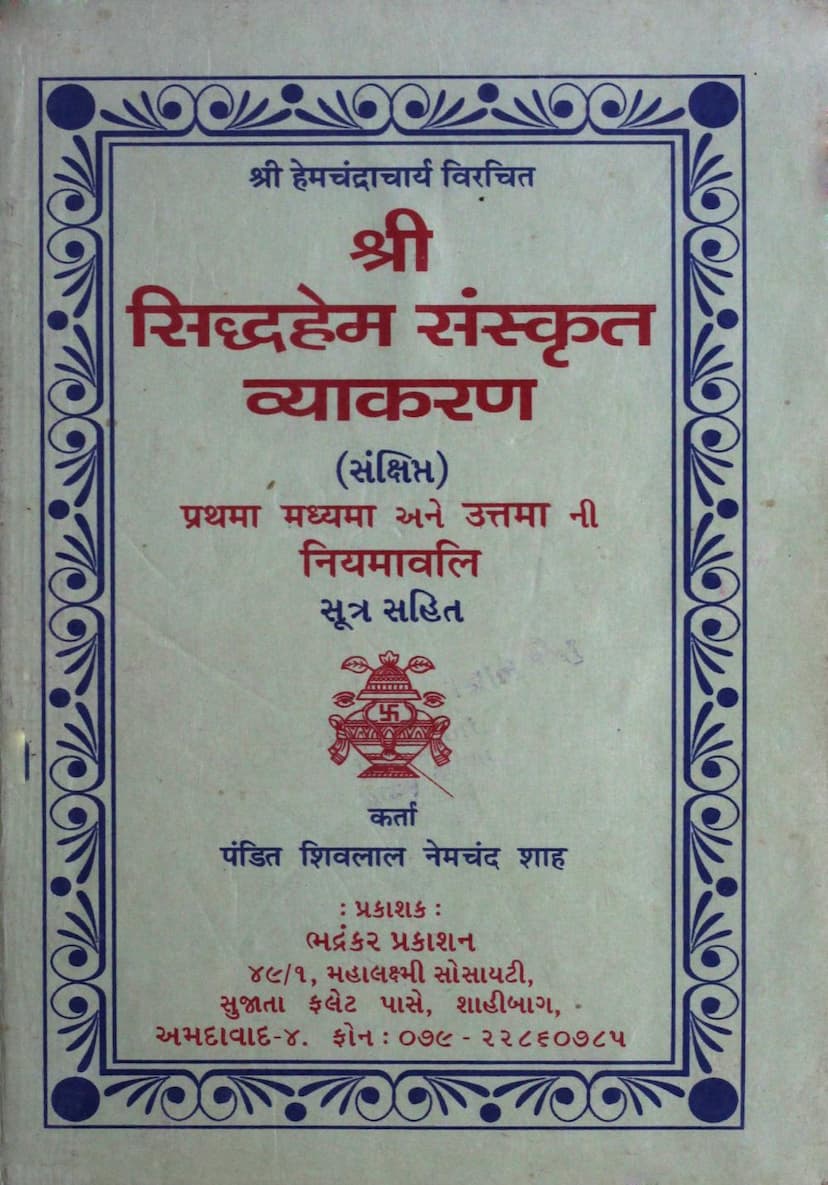Siddhahem Sanskrit Vyakarana
Added to library: September 2, 2025

Summary
This comprehensive summary of the "Shri Siddhahem Sanskrit Vyakarana (Sankshipt)" by Hemchandracharya, compiled by Pandit Shivalal Nemchand Shah and published by Bhadrankar Prakashan, outlines a concise and structured approach to learning Sanskrit grammar based on Hemchandracharya's monumental work, Siddhahem Vyakarana. The book is divided into three parts: Prathama (Primary), Madhyama (Intermediate), and Uttama (Advanced), each systematically covering the rules and sutras of Sanskrit grammar.
Key Features and Structure:
The book aims to provide a systematic and accessible learning path for students of Sanskrit. Its core strengths lie in its clear organization, inclusion of original sutras, and simplified explanations.
-
Systematic Progression: The text follows a logical progression from foundational concepts to more complex grammatical structures.
-
Sutra Integration: Each grammatical rule is accompanied by its corresponding sutra from the Siddhahem Vyakarana, allowing for direct reference and deeper understanding.
-
Categorization: The grammar is meticulously categorized into:
- Varna Vichar (Phonetics): Covering vowels, consonants, their articulation points, and classifications (e.g., short, long, pluta, nasalized).
- Shabd Vichar (Morphology): Dealing with nouns, verbs, their formations, cases (vibhakti), tenses, moods, and other word-related aspects.
- Sandhi (Euphony): Explaining the rules of sound combination.
- Samas (Compounds): Detailing various types of Sanskrit compound words (e.g., Tatpurusha, Dv dvandva, Bahuvrihi, Avyayibhav).
- Kridanta (Gerunds/Participles): Explaining the formation and usage of verb-derived nouns.
- Taddhita (Derivations): Covering suffixes used to derive nouns from other nouns, indicating relationships, qualities, or actions.
- Prakriya (Processes): Illustrating the step-by-step application of grammatical rules.
- Prayog (Voice): Explaining Karmani Prayog (Passive Voice) and Bhave Prayog (Impersonal Voice).
- Kala (Tenses): Covering Vartamana (Present), Hyastan (Imperfect), and Bhavishyati (Future) tenses.
- Arth (Moods): Including Vidhyarth (Subjunctive/Optative), Ajnarth (Imperative), and Ashish (Benediction).
-
Detailed Content (Prathama - Primary):
- Chapter 1: Varn Vichar: Introduces the Sanskrit alphabet, classifying vowels and consonants, discussing their pronunciation, pronunciation places (sthan), efforts (prayatna), and classification based on voice (ghosh) and lack of voice (aghosh). It also covers concepts like vowel length (matra), nasalization (anunasika), and the distinction between roots (dhatu) and names (nama).
- Chapter 2: Shabd Vichar: Introduces the concept of dhatu (root verbs) and nama (nouns), and begins the study of verb conjugations (Parasmai pada and Atmane pada), starting with the first conjugation (Parasmai pada). It delves into vibhakti (case endings) and avyaya (indeclinables).
- Subsequent Chapters (Prathama): Progress through various noun declensions (e.g., akarant pulling, sakarant napumsak, sakarant striling), the formation of different vibhaktis (case endings), sandhi rules, verb conjugations across different ganas (verb classes), passive and impersonal voices, past and future tenses, compound words (samasa), and derivation of nouns (taddhita). The text provides detailed explanations of specific verb roots and their transformations.
-
Madhyama (Intermediate) and Uttama (Advanced): These sections build upon the foundational knowledge, covering more advanced verb conjugations (including irregular verbs), complex sandhi rules, advanced samasa formations, intricate taddhita derivations, and the application of various grammatical processes. The Madhyama section appears to cover verb roots from different ganas and verb classes in detail, while Uttama delves into more nuanced aspects like cridanta (participles) and extensive taddhita rules.
Key Concepts Explained:
The book meticulously explains fundamental concepts of Sanskrit grammar as per the Siddhanta-Kaumudi tradition, but rooted in Hemchandracharya's extensive framework:
- Dhatu (Roots): The primary building blocks of verbs.
- Nama (Nouns): Including their declension through cases (Prathama to Saptami) and numbers (singular, dual, plural).
- Vibhakti (Case Endings): Crucial for understanding grammatical relationships in a sentence.
- Sandhi: The euphonic rules that govern the joining of sounds.
- Samasa: The rules for forming compound words.
- Kridanta: Derived words from verbs, often functioning as adjectives or nouns.
- Taddhita: Suffixes that modify nouns to indicate relationships, ownership, or qualities.
- Prayoga (Voice): Active, Passive, and Impersonal voices.
- Kala (Tense): Present, Past (various forms), and Future.
- Lakaar (Mood): Indicative, Imperative, Subjunctive, Benedictive, etc.
Overall Purpose:
The "Shri Siddhahem Sanskrit Vyakarana (Sankshipt)" by Pandit Shivalal Nemchand Shah serves as a valuable resource for students aiming to master Sanskrit grammar, particularly within the Jain tradition which holds Hemchandracharya's work in high esteem. It simplifies a vast and complex subject, making it accessible for learners at different levels of proficiency. The inclusion of sutras ensures authenticity and provides a direct link to the original text. The book is presented as a guide for students to achieve proficiency and ultimately spiritual upliftment through the study of language.
This summary is based on the provided text, highlighting the structure, content, and pedagogical approach of the book.